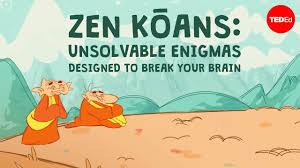(单词翻译:单击)
How do we explain the unexplainable?
我们应如何解释不可解的事物?
This question has inspired numerous myths, religious practices, and scientific inquiries.
这个问题衍生出了无数神话、宗教习俗和科学调查。
But Zen Buddhists practicing throughout China from the 9th to 13th century asked a different question -- why do we need an explanation?
但九世纪至十三世纪的中国古代禅师们却抱有不同的疑问--为何我们需要找出解释呢?
For these monks, blindly seeking answers was a vice to overcome,
对这些禅师们来说,盲目地追寻答案是一种需要克服的恶习,
and learning to accept the mysteries of existence was the true path to enlightenment.
而学会接受存在之不可解才是通往开悟的真正道路。
But fighting the urge to explain the unexplainable can be difficult.
然而,解释不可解之谜常常是一种难以克服的冲动。
So to help practice living with these mysteries,
所以为了让自己习惯和谜题共存,
the meditating monks used a collection of roughly 1,700 bewildering and ambiguous philosophical thought experiments called kōans.
禅师们借助了一千七百则被人称作“公案”的令人不解、寓意不明的哲学思想实验。
The name, originally gong-an in Chinese, translates to "public record or case."
“公案”原意指官府用以判断是非的案牍。
But unlike real-world court cases, kōans were intentionally incomprehensible.
但禅宗的“公案”内容却扑朔迷离,这是有意为之的。
They were surprising, surreal, and frequently contradicted themselves.
它们令人惊奇、十分荒诞且时常自我矛盾。
On the surface, they contained a proverb about the Zen Buddhist monastic code
表面上,一则公案似乎意指某条禅宗清规,
such as living without physical or mental attachments, avoiding binary thinking, and realizing one's true "Buddha-nature."
例如放下执念,避免二元对立的思维和了解自己真正的“佛性”等等。
But by framing those lessons as illogical anecdotes, they became tests to help practicing monks learn to live with ambiguity and paradox.
但把这些教谕通过不合逻辑的小故事呈现,它们就变成了一个个测试,让禅师们习得与迷惘和矛盾共存的方法。
By puzzling through these confusing "cases," meditating monks could both internalize and practice Buddhist teachings.
冥想中的禅师们分析“公案”时,便能同时内化和实践佛的教诲。
Hopefully, they would let go of the search for one true answer and trigger a spiritual breakthrough.
假以时日,他们能学会放下对唯一的真理的追寻,抵达开悟的境界。
Since these are intentionally unexplainable, it would be misguided to try and decipher these stories ourselves.
由于公案本来就不可解释,我们不应该尝试着自己解读这些故事。
But like the monks before us, we can puzzle over them together, and investigate just how resistant they are to simple explanations.
而应如从古至今的无数禅师一般,我们可以一起为它们绞尽脑汁,研究它们到底是多么难以被简单地诠释。
Consider this kōan illustrating the practice of no-attachment.
比如这个描述“破我执”的公案。
Two monks, Tanzan and Ekido, are traveling together down a muddy road.
Tanzan和尚与Ekido和尚出游时,走过一条泥泞路。
Ahead they see an attractive traveler, unable to cross the muddy path.
他们碰到了一名美貌的旅人正因为无法跨过小路而烦恼。
Tanzan politely offers his help, carrying the traveler on his back across the street, and placing her down without a word.
Tanzan礼貌地伸出援手,将旅人背过了泥泞路,然后默默地把她放了下来。

Ekido was shocked. According to monastic law, monks were not supposed to go near women, let alone touch a beautiful stranger.
一旁的Ekido很吃惊。根据佛教清规,僧人不可近女色,更不可触碰貌美的陌生人。
After miles of walking, Ekido could no longer restrain himself. "How could you carry that woman?"
又走了几里路,Ekido才忍不住说道:“你怎么能就这样把她背过去呢?”
Tanzan smiled, "I left the traveler there. Are you still carrying her?"
Tanzan笑道:“我早就把她放下了。你还背着吗?”
Like all kōans, this story has numerous interpretations.
如同其它公案一样,这个故事也有着多种诠释。
But one popular reading suggests that despite never having physically carried the traveler,
一种比较普遍的说法是Ekido虽未实际上背负旅人,
Ekido broke monastic law by mentally "clinging to" the woman.
但心中却还挂念着她,打破了佛教清规。
This type of conflict -- examining the grey area between the letter of the law and the spirit of the law -- was common in kōans.
这种矛盾揭示了法律的字面意义和其精神之间的灰色地带,是许多公案的主题。
In addition to exploring ambiguity, kōans often ridiculed characters claiming total understanding of the world around them.
除了探索事物的模棱两可,公案时常挖苦那些自以为无所不知的人。
One such example finds three monks debating a temple flag rippling in the wind.
例如在一则公案中,三个僧人对着寺庙前的旗子展开了争论。
The first monk refers to the flag as a moving banner,
第一个僧人说旗子在动,
while the second monk insists that they are not seeing the flag move, but rather the wind blowing.
但第二个僧人却认为旗子没动,是风在动。
They argue back and forth, until finally, a third monk intervenes,
他们争论不休,直到第三个僧人打断他们,说:
"It is not the flag moving, nor the wind blowing, but rather the movement of your minds!"
“不是旗子在动,也不是风在动,而是你们的心在动。”
One interpretation of this kōan plays on the supposed wisdom of the arguing monks
这个公案可以被看作对前两个僧人的“智慧”的讽刺。
the first asserting the importance of the observable world, the second favoring deeper knowledge we can infer from that world.
第一个执着于可观察的世界的重要性,第二个更注重于考察其背后的奥义。
But each monk's commitment to his own "answer" blinds him to the other's insight,
但两个僧人对自己的“答案”的执着使他们拒绝认同对方的看法。
and in doing so, defies an essential Buddhist ideal: abolishing binary thinking.
如此,他们违反了佛教的根本理念:摒除二元对立的思维。
The third monk identifies their conflict as a perceptual one -- both arguing monks fail to see the larger picture.
第三个僧人认为问题在于两人的心被外物迷惑了,一叶障目,不见泰山。
Of course, all these interpretations only hint at how to wrestle with these kōans.
当然了,这些诠释只不过提示了我们要如何看待这些公案。
Neither the wisdom from practicing monks before us, nor the supposedly wise characters in these stories can resolve them for you.
无论是前人的智慧,还是故事中的得道高僧,都无法真正解答它们。
That's because the purpose of these kōans isn't reaching a simple solution.
因为公案存在的意义不在于找出解答。
It's the very act of struggling with these paradoxical puzzles which challenge our desire for resolution,
寻找答案的过程本身考验着我们对寻找出答案的执着
and our understanding of understanding itself.
以及我们对自己的思考过程了解多少。


